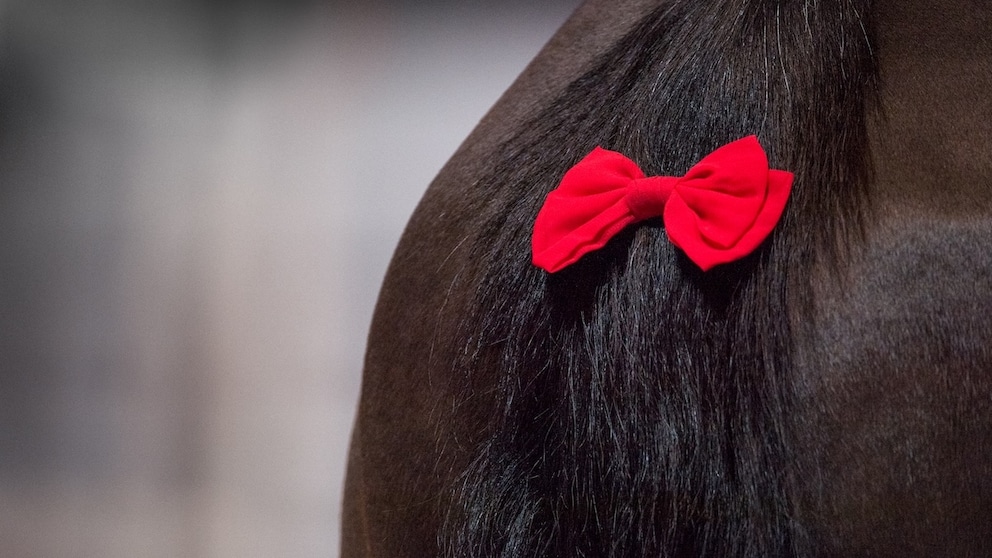March 5, 2025, 9:20 am | Read time: 4 minutes
Anyone who is out and about at competitions or in large riding stables has certainly seen them before: colorful ribbons on the horse’s tail. But these colored ribbons are by no means mere decoration — they serve as important warning and information signals. If you know what they mean, you can avoid misunderstandings and dangerous situations.
Colorful ribbons on horses are not just for decoration. They are internationally recognized signals that indicate certain behaviors or special features of the animal. They inform other riders about potential dangers, special needs, or even sales offers. The red ribbon is particularly important as a warning against certain horses.
Overview
Colored Ribbons on Horses as Important Identification
Some dog owners are now familiar with colored ribbons, especially yellow ones. However, while the importance of “gula dogs” is still being recognized, the use of ribbons on horses has long been established. The different colors of the ribbons also have a clearly defined meaning. They can indicate that a horse is aggressive, quick to kick out, or particularly inexperienced. Knowing and reacting to the colors contributes significantly to safety in the stable or at competitions.
Red Ribbon
A red ribbon in the tail means: caution! The horse has a tendency to suddenly start to kick. The reasons for this can vary — it could feel uncomfortable around other horses, be under stress, or be irritated by the cramped conditions at a competition. Kicking is also a learned behavior in horses, which actually serves as a last resort for communication when the animal is particularly anxious. It is particularly important to keep your distance in the stable, in the warm-up arena, or when riding out together.
Legal Significance of the Red Ribbon
If a horse with a tendency to kick out does not wear a red ribbon, this can have serious consequences. Not only does the risk of injury to others increase, but there may also be consequences under liability law. In 2006, the Koblenz Higher Regional Court ruled that horses with a known tendency to kick must wear a red ribbon (5 U 319/04). If this is not the case, the owner can be held fully liable in the event of damage. Anyone who knows that their horse could kick out should, therefore, make this clear with a red ribbon on its tail!
Blue Ribbon
A blue ribbon indicates that the horse is a stallion. These animals can react impulsively in certain situations, especially around mares in heat. Anyone who owns a mare should, therefore, be particularly careful.
Purple Ribbon
Not only stallion owners but also those with mares in heat should use this marking. These mares should then wear a clearly recognizable purple ribbon so that riders on stallions can avoid them. But this is also important information for other horse owners, as the mare could also react irritably or unpredictably to other horses.
Yellow Ribbon
The yellow ribbon warns that a horse is behaving aggressively towards other horses. It is reserved exclusively for stallions or geldings. This signal can be particularly important in narrow areas such as stable aisles or in the warm-up arena. A certain safety distance is always advisable.
Green Ribbon
A young or untrained horse often wears a green ribbon. Other riders should take care to remain calm, avoid abrupt movements, and not put the horse under unnecessary stress. It is best to avoid the “green ribbon” during training as far as possible.
White Ribbon
Anyone interested in buying a horse should look out for a white ribbon on the tail. This marking indicates that the horse is for sale — interested parties are welcome to ask the owner about it.

High-maintenance thoroughbreds Why former racehorses are not always suitable for leisure riding

Critically endangered These are the rarest horse breeds in the world

Tips & Training How to correctly train the rider’s seat and why it is important for the horse
Important Note on the Use of Ribbons on Horses
Colored ribbons should only be used if they actually have a meaning. They are not decorative elements but serious markings with practical use. They are clear signals for safe interaction. This simple but effective method reduces misunderstandings between riders when handling animals.
The red and green ribbons are particularly important for the safety of people and animals at shows and in riding stables. Responsible riders use these signals to show consideration for others and minimize risk. After all, these sensitive flight animals have tremendous strength. Ribbons on horses can help to prevent accidents and ensure that neither humans nor animals are injured.

